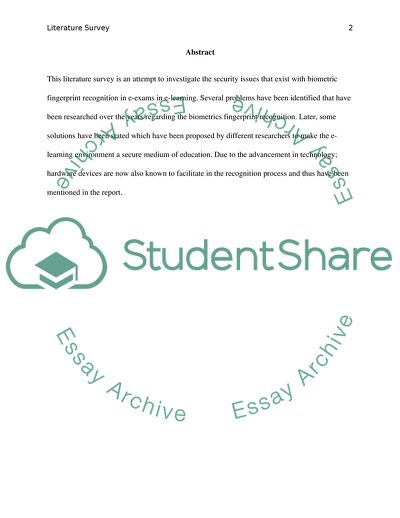
- Home
- Free Samples
- Premium Essays
- Editing Services
- Extra Tools
- Essay Writing Help
- About Us
- Studentshare
- Subjects
- Miscellaneous
- Using Biometrics Authentication via Fingerprint Recognition in E-exams in E-Learning Environments
Using Biometrics Authentication via Fingerprint Recognition in E-exams in E-Learning Environments - Essay Example

- Subject: Miscellaneous
- Type: Essay
- Level: Undergraduate
- Pages: 4 (1000 words)
- Downloads: 0
- Author: kuhicjessy
Extract of sample "Using Biometrics Authentication via Fingerprint Recognition in E-exams in E-Learning Environments"
The world of today has witnessed great advancement in every field, especially information technology. This has enabled the educational institutions to implement new form of teaching environments which are e-learning systems [2]. E-learning environments security is essential to establish the concept as a trusted supporting medium for learners [1]. There are a number of security threats related to the area of e-learning and most of them for electronic submission of tests, assignments etc. It is argued that e-learning systems are not able to fully authenticate their students while holding online examinations or submissions [3].
Huang et al criticized existing system for not authenticating the students, especially when examinations are being held [4]. He also emphasized that there were many security technologies that have still not been employed in e-learning. One of security technologies which is gaining name in e-learning environments is the biometric technology. It has been explained by Williams [5] that biometrics systems are dependant on the individual features of the person such as fingerprints, retinal image, hand prints etc.
These features can serve very well to identify and authenticate an individual as all these things are unique in humans. Fingerprint recognition is known as a common biometric system because of its ease of use, accuracy and performance [6]. McGinity [28] states that although biometrics has moreover replaced the traditional username-password systems, but security threats still exist. Ratha et al. [7] and Maltoni et al. [12] have analyzed these attacks which shall also be discussed in the paper.
The quality of the fingerprint plays an important part in the recognition of the individual and thus performance of the system. Prabhakar et al. [32] explains that the matching technique can be divided into two categories; one is the minutae-based and the other is correlation-based. In the first technique, minutae
...Download file to see next pages Read More
- TERMS & CONDITIONS
- PRIVACY POLICY
- COOKIES POLICY